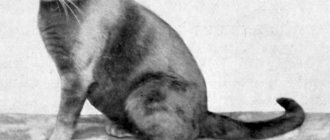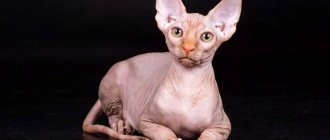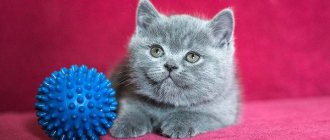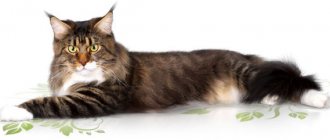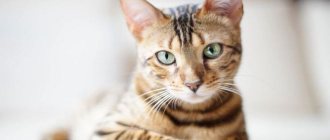Cymric (also called the Welsh cat) is an animal that combines the features of a cat, a dog and a rabbit. From the front the pet looks like an ordinary stocky domestic cat, and from the back it looks like something between a bulldog and a hare. A representative of the Cymrik breed is an affectionate, playful cat with the habits of an intelligent watchdog. Such cats are excellent rat catchers and home guards. In their free time, they behave calmly and peacefully. The balanced islander will be a wonderful addition to any family.
Origin story
The birthplace of Cymric is the small Isle of Mans near Great Britain. The first mention in sources dates back to 1750. Close relatives of the Cymrics, the Manx, also appeared on the same island. However, despite the external similarity, these are different breeds, and it is a mistake to believe that the fluffy Cymric is a long-haired Manx.
Local residents jokingly call Cymrics a cross between cats and rabbits due to the complete absence of a tail. But this is the result of a complex genetic mutation that appeared a long time ago (more than four hundred years ago).
The tailless cats that were born did not correspond with anyone and continued to mate with each other (since the island was considered closed for a long time, representatives of other cat breeds were not brought there).
This type of mutation is called the “bottleneck effect” by geneticists, but the length of the appendage in kittens from the same litter may be different. Currently, this feature is supported by the works of breeding breeders.
In 1960, amazing tailless babies came to Canada, and that’s where they began to gain popularity. However, they were recognized as an independent breed only in 1967, and even then, some authoritative organizations still refuse to recognize them and still believe that the Cymric is just a type of Manx.
There are few nurseries engaged in breeding Cymrics. In Russia and neighboring countries there are none at all, so purchasing a kitten is an extremely expensive and troublesome matter.
Cymric health
As a native breed, the Cymrik is unusually strong, resilient and healthy. He does not suffer from any heart disease, is not susceptible to infections or colds, and has no intestinal problems.
However, the Cymrics are characterized by some deviations associated with the structural features of their body; This:
- A mutant gene that is responsible for taillessness in Cymrics. It is recessive and penetrative (that is, it may or may not be present in both anurans and caudates). To give birth to healthy kittens, one of the parents must not be a carrier of the gene. If both are carriers, then the offspring will be born dead.
For the birth of healthy offspring from a Cymric, competent selection is important
- Manx syndrome is a dangerous disease that can appear in kittens from birth to 6 months. It manifests itself in shortening of the spine, which leads to hernia, fusion of vertebrae and many other problems. Tailed Welsh cats are much more susceptible to this syndrome. Therefore, breeders often dock the tails of kittens at the age of a week. They do this for other reasons: in tailed Cymrics, at the age of 4–5 years, the spine may stiffen. Cupping at this age is dangerous, but kittens tolerate it without complications.
Manx syndrome affects kittens under 6 months of age
Standards
Despite the fact that the popularization of the breed has not happened so far, the standards for the Cymric were still prescribed by the American TICA system.
| Standard | Description |
| Head | Wedge-shaped, with clearly defined cheeks, cheekbones and whisker pads. The forehead is slightly rounded, with smooth lines. The chin is neat, there is a slight “stop” on the bridge of the nose, and the nose is medium. The neck is powerful and short. |
| Eyes | Large, round, widely spaced, the outer corner clearly raised. The color of the eyes corresponds to the color of the coat: they can be blue, green, yellow. Rarely, heterochromia occurs. |
| Ears | Small, spaced, with a wide base and rounded tips. Both the outer and inner edges are covered with dense pubescence. Sometimes miniature tassels are observed at the tips of the ears. |
| Torso | Strongly built (cobby type), strong bones. The belly line is low, the back is short. |
| Paws | Muscular, the front ones are shorter than the rear ones (thanks to this, Cymrics are excellent jumpers). The pads are elastic and medium in size. Tufts of fur grow between the fingers. |
| Wool | Long, soft and silky to the touch. The undercoat is thick and elastic, making the coat appear double. There are “pants” on the hind legs, and a “collar” on the neck. |
| Weight | The average weight of a male is 5-6 kg, a female is 3.5-4 kg. Prone to dimorphism. |
Photo of a cat of the Cymrik breed
Tails
There are 4 types of tail:
| Name | Description |
| Rumpy | Ideal for show rings and exhibitions, complete absence of tail. In its place there is often a depression. |
| Rumpy-riser | There is a tail, but it is short (1-3 vertebrae). Exhibition events are allowed in one case: if the judge’s hand, when stroking the cat, does not touch the tail in a vertical position. |
| Stumpie | The tail is longer than that of ramp risers; it may have knots and creases. Simple domestic cats are not allowed for breeding. |
| Longi | The tails of individuals are the same as those of other breeds, but some breeders dock them a week after birth. This is done for purely commercial purposes: those who want to buy a Cymric want to get a cat without a tail. |
Breed faults: eyes that are close together or deformities; graceful physique; short hind legs; color hybridization; extra fingers; cryptomorphism; weak hind legs.
Cymric Breeding
Kymriks are very rare and few in number. There are nurseries for these cats only in Western Europe, the USA and Canada. It is prohibited to export uncastrated and unsterilized cats to people who do not own a professional cattery. Therefore, it is unlikely that it will be possible to breed these beautiful animals. However, several interesting details of their breeding are known:
- You cannot cross two Cymrics with a rumpy tail, since the offspring are born dead (a side effect of the mutant gene): breeders solved this problem by crossing rumpy cats with longy and stumpy cats.
- The percentage of completely tailless offspring rarely exceeds 25%.
- 25% of kittens die in the first stages of fetal development, so a Cymric never has more than 4-5 babies in a litter.
- Cymrics and Manxes, as related breeds, are allowed to be crossed. The offspring are considered Cymric regardless of coat length. Short-haired Cymrics (which are actually Manx!) are considered pet-class animals, even with a short tail.
Breeding Cymrics is not trusted by beginners and non-professionals
Colors
Colors are varied.
- Torti;
- Bi (tabby with milk spots, harlequin);
- Tabby (mackerel, brown, silver, red, bluish);
- Smoke (blue, silver or silver-black);
- Silver chinchilla;
- Red, red;
- Cream;
- Black (with amber or emerald eyes);
- Blue color with topaz or green eyes;
- Completely white with topaz colored eyes, green or different.
Himalayan, chocolate and lavender colors are not allowed!
Character and behavior
You can't find more intellectuals like the Cymrics. They are easy to train: they can remember up to a dozen commands, learn to close and open doors, and carry light objects (rolled newspaper, their toys). If you start to accustom your baby to a harness, he will be happy to walk in full gear with his owner down the street. If you give a Cymric a tasty piece, he will never refuse it, even if he is full, but will hide the delicacy in a secret place, away from prying eyes.
Cymriki are not afraid of water, unlike most cats, which is why they love water treatments. This will be a great help for the owner: you won’t have to restrain a cat that is trying to get out of your hands: just lay a diaper on the bottom of the bath and turn on the water warmer.
Individuals of this breed are the best hunters. They are not afraid of mice, rats, or birds, which is a bit of a problem: having parrots or small rodents in the same apartment is risky. If you don't care, you'll have one less pet. And it will definitely not be a Welsh cat!
The speed of the Cymric's reaction is amazing: he can instantly assess the situation and, if something happens, attack an object that seems suspicious to him. Especially if he notices the owner’s concern about this. Therefore, in the same company as him, you should not raise your voice, behave emotionally or show aggression.
What breeds do you prefer?
ShorthairLonghair
But if the cat feels the owner’s calmness, then he himself remains calm and unperturbed. His favorite pastime is being next to his adored owner. It is worth noting that the Cymrik is devoted like a dog: it follows its loved one from room to room, sits on the shoulder or purrs on the lap. Doesn't like noisy companies or loud sounds. Doesn't cry in vain. The Cymric's voice is very pleasant: soft and thin, with an interesting set of sounds and intonations. Extremely curious.
He doesn’t mind playing with a ball or a toy mouse, he’s bouncy and will climb onto any closet and any shelf in the apartment. Therefore, if renovation is important to you: place a large and high cat corner in the room, where the cat can throw out excess energy.
He is attentive and friendly towards children, ready to run around the rooms with them. She cannot stand separation: she becomes very sad, refuses to eat, and may even become seriously ill. Accustom your pet to travel by car or other transport: if you do this from an early age, your cat will be pleasant company for you on your travels.
Expert opinion
Dusheba Vera Ivanovna
In 2010, she graduated from the Moscow State Academy of Veterinary Medicine named after K.I. Scriabin with honors, specializing in veterinary medicine. I regularly attend veterinary conferences, congresses, and webinars.
The cost of a show kitten is approximately a thousand dollars; if a defect is detected, the price is slightly reduced. When choosing a baby, adhere to several criteria: appearance, behavior, availability of documents (passports with information about vaccinations and pedigree) and the health of the kitten. The toddler should have clean mucous membranes, skin without rashes and irritation, ears and eyes without discharge. Bad breath is a sign of stomach problems.
Upbringing
Welsh cats have developed intelligence.
Teaching them the rules of behavior in the house is not difficult. They quickly remember where the litter tray and scratching post are, and how to use them. If desired, they can be toilet trained.
Usually babies are taught to go to the toilet by their mother cat in the breeder's house. In the apartment of the new owners, he just needs to show him where the pot is and put the kitten in it several times after eating or sleeping. If the short-tailed dog nevertheless relieves itself in the wrong place, under no circumstances should it be hit. The cat will associate punishment not with a mistake, but with a process. She will begin to hide, try to write in secret from people.
Another important point - the avid hunter Kymrik is initially prohibited from teaching him to play with his hands
If the baby begins to bite or scratch, his attention needs to be switched to toys purchased specifically for him. Over time, he will understand what he can play with and what he can’t.
Advice! Welsh cats should not be shouted at. They are very touchy, they will simply hide and will not come out of hiding for a long time. It is better to talk to your pet in a calm, firm voice.
Smart Cymriks can be easily taught simple commands. Training should be carried out in the form of a game, when the pet is in the mood, and stop the lesson if the cat gets tired of following commands. Then the furry predator will be happy to fetch and give paws
Shorttails appreciate the attention of their owner. Spending time together gives them great pleasure
Care instructions
The cat must have its own personal belongings: a bed or house, a scratching post, grooming products, bowls, a harness and leash, a play set, toys, a litter tray. The tray is placed in a secluded corner, where, however, the cat will have access at any time, and the bed is placed in the room where the owner most often visits.
Wool
The dense double coat of the Welsh cat requires careful and thorough grooming. During molting, Cymriks are combed every day, the rest of the time - 2 times a week.
Claws
The claws are shortened as necessary: in representatives of this breed they grow back instantly. After cutting off the excess, file the ends with a nail file.
Ears
The ears are cleaned with a regular cotton swab dipped in chamomile decoction or pharmacy lotion (Bars, Euracon Pharma GmbH OTOKLIN, VETOQUINOL Otifri) once a week. Eyes are wiped only when dirty.
Teeth
Photo of a cat of the Cymrik breed.
Teeth are brushed every week: buy your pet a silicone toothbrush and a special paste for cats. The Cymric is not threatened with caries, but tartar forms on the teeth quite often. They begin to get used to brushing at 8-12 weeks (1-2 brushings per month). For an adult animal, cleaning a week is enough. Take your cat to a specialist once a year.
Toothpastes: Trixie (Germany), Beaphar Toothpaste (Netherlands), Hartz (USA). In addition to pastes, there are special sprays (Sentry Petrodex Dental Spray, Api-San Zubastik, Beaphar Fresh Breath Spray), gels (TropiClean), water additives (TropiClean Water Additive Original) and snacks (Beaphar Cat-a-Dent Bits, GimCat "Denta-Kiss", "Mnyams Healthy Teeth").
Catering
Cymrics are not picky when it comes to food. You can choose what to feed them: industrial feed or natural food.
Natural products
Kittens usually come home at the age of 2-3 months, and they already know how to eat on their own. Their diet should be rich in protein and vitamins. You can give your baby lean beef and minced chicken, boiled vegetables, porridge (liquid semolina, oatmeal), low-fat cottage cheese, kefir, quail egg. Diet: 6 feedings per day. Food – only warm! Hot will burn the gastric mucosa, cold will not allow food to be properly absorbed.
Photo of a kitten of the Cymrik breed
At 4 months, kittens are slowly transferred to more adult food. The menu includes tripe, kidneys, liver, boiled or raw vegetables (turnips, carrots, cauliflower). Number of feedings – 5.
Adult cats have a more extensive diet. It includes cheese, low-fat sour cream, bio-yogurt, lamb and rabbit meat, sea fish, cucumbers, and asparagus. Number of feedings – 2: morning and evening.
It is forbidden to give Cymrics:
- Salted, fried, smoked, canned, fatty;
- Sweet;
- Flour;
- Bones;
- Freshwater fish;
- Alcohol, tea, coffee, soda, mineral water,
- Tomatoes, potatoes;
- Pea, chickpea, bean porridge;
- Pork, duck;
- Dishes from the human table (soups, borscht, pickles and tomatoes, pasta).
You cannot feed your cat alternately natural food and food. Choose one thing, otherwise he will have an upset digestive system. When buying industrial feed, if possible, choose manufacturers of super-premium and holistic class feed. Economy class food negatively affects the health of the animal, and the composition of premium food leaves much to be desired. Make sure your diet is balanced with calcium, protein, and taurine.
A Cymric should always have clean and warm water freely available. Change it morning and evening.
Buy special cat grass for germination at a veterinary pharmacy. The cat will feast on it as needed.
Pregnant and sick animals need more nutrients, so the diet is revised. Choose the feeding frequency yourself, based on the cat’s condition.
Recommended food
Below are recommended super premium foods, links with food names are clickable. Using them, you can, within our website, read descriptions of food and read reviews from owners of the Cymrik cat breed.
| Super premium | Holistic | Premium |
| Sanabelle | Savarra | Royal Canin |
Feeding the cat
Food for Cymric should be well-balanced and sufficiently nutritious. It is important that it contains all the necessary vitamins and microelements and that there are no questionable additives. The following brands of dry food are best suited for Cymri cats:
- Pro Plan;
- Gemon;
- Pronature;
- Bosch;
- Eukanuba.
With a natural type of nutrition, representatives of the breed are selected a diet that contains 70-80% meat. Additionally, the Cymri cat is given:
- vegetables;
- porridge;
- offal;
- eggs;
- sour milk;
- ocean fish.
It is forbidden to feed the Cymric pork, onions, beans, potatoes, pastries, sweets, smoked meats and sausages. You should also not give your cat exotic fruits, river fish, fresh milk or any food from the owner’s table.
Diseases
I would like to write that Cymrics are healthy animals that can live for many years to the delight of their owner, but... The mutated M gene causes many developmental defects. First of all, the death and mummification of embryos in the mother’s womb (in cats with a pair of dominant genes of the MM type). Unfortunately, kittens in this case are completely unviable.
Offspring with mixed heredity survive - according to the Mm type. This is why it is difficult to get a healthy Welsh cat and why they are so rare and expensive.
Breeders do not allow mating of two standard Manxes or Cymrics. The second partner is a stumpy cat (with a regular tail) or a British shorthair.
Kittens that receive one gene survive and are at risk of developing Manx syndrome. It is characterized by bifida and other defects of the spine, pathologies of the bladder, stomach and intestines. All these ailments appear in the first 4-6 months after the baby is born (that is why decent breeders do not sell kittens before this period).
The Kymrik should not be patted or roughly stroked in the place where the tail is supposed to be: nerve endings are present there, they are not protected by anything and cause discomfort and even pain to the animal.
Expert opinion
Dusheba Vera Ivanovna
In 2010, she graduated from the Moscow State Academy of Veterinary Medicine named after K.I. Scriabin with honors, specializing in veterinary medicine. I regularly attend veterinary conferences, congresses, and webinars.
To avoid additional stress on the spine, when you lift the Cymric in your arms, support its hind legs.
Cost of a kitten
The main rule for Manx and Cymrik lovers is to buy kittens only from foreign nurseries, with a full package of documents, checking the pedigree and health of the parents. Otherwise, there is a danger of acquiring ordinary yard cats with docked tails.
You can pick up a kitten only after six months - by this time it will be obvious that the threat of the animal being affected by Manx syndrome has passed.
The cost of kittens varies greatly depending on a number of factors: tail length, gender, pedigree, color, individual characteristics of individuals. The usual price in American, English and Canadian nurseries is from 300 to 1,000 US dollars.
1111
Photo gallery
Below are photos of cats of the Cymric breed (another name is Welsh cat).
nadezhdavetmsk
bastrakova86
mokrynosik
katalogporod
chudakova_morozenko
liaosina
Nature of Shorttails
Mentions of this breed date back to the end of the 18th century. The Isle of Man is very small and none of the cats that lived on it in those days had a long enough tail. Almost all pets were tailless.
During the evolution of the breed, the tail remained short, and the coat remained thick and long. It's all about the climate. Not to say that it is very harsh, but the undercoat was very useful for these cats in the cold season.
Everyone is used to seeing dark gray, “marbled” and silver-gray cats of this breed. But there are also red Cymrics, as well as cream colored ones. They are very beautiful. In addition, they have a very learned appearance and are calm.
You can admire a photo of the Cymrik cat below. The most striking varieties of colors with characteristics characteristic of the breed are presented.


